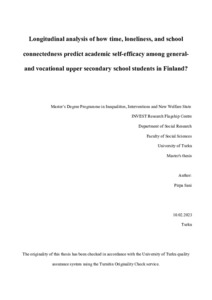Longitudinal analysis of how time, loneliness and school connectedness predict academic self-efficacy among general- and vocational upper secondary school students in Finland?
Sani, Pirpa (2023-02-13)
Longitudinal analysis of how time, loneliness and school connectedness predict academic self-efficacy among general- and vocational upper secondary school students in Finland?
Sani, Pirpa
(13.02.2023)
Julkaisu on tekijänoikeussäännösten alainen. Teosta voi lukea ja tulostaa henkilökohtaista käyttöä varten. Käyttö kaupallisiin tarkoituksiin on kielletty.
avoin
Julkaisun pysyvä osoite on:
https://urn.fi/URN:NBN:fi-fe2023060952996
https://urn.fi/URN:NBN:fi-fe2023060952996
Tiivistelmä
Previous longitudinal research revealed that academic self-efficacy (ASE) is affected by loneliness (Chemers, Hu, & Garcia 2001, Galla et al. 2014). The current thesis investigates the association of ASE to loneliness and school connectedness (SC) in the general- and vocational upper secondary schools, and the Finnish adolescents over time. Results confirm what was previously reported in a cross-sectional study concerning an association between ASE and loneliness (Grotan et al. 2019). In the current thesis, panel data from three waves produced evidence of temporal outcomes. The results suggest a descending trend in ASE and SC, while loneliness reveals an ascending trend over three semesters, at individual level in both school types. Moderate school type differences occur. Both schools ASE decline was statistically significant over time. The negative effect of time and loneliness on ASE continues throughout the models. The positive effect of school connectedness on ASE is significant in all the models, particularly for the vocational upper secondary school (VUSS). Research was conducted with fixed effects (FE) method and interaction terms. Interaction results reveal that ASE increases the most for those VUSS students whose school connectedness is elevated. However, the causal relationship cannot be detected with the current method.
